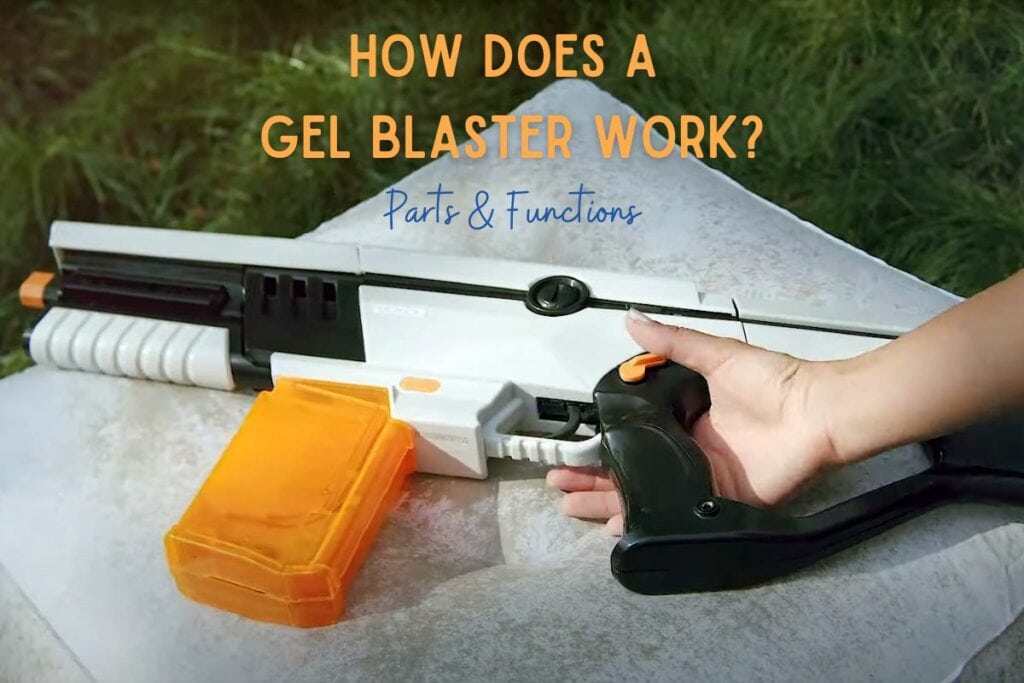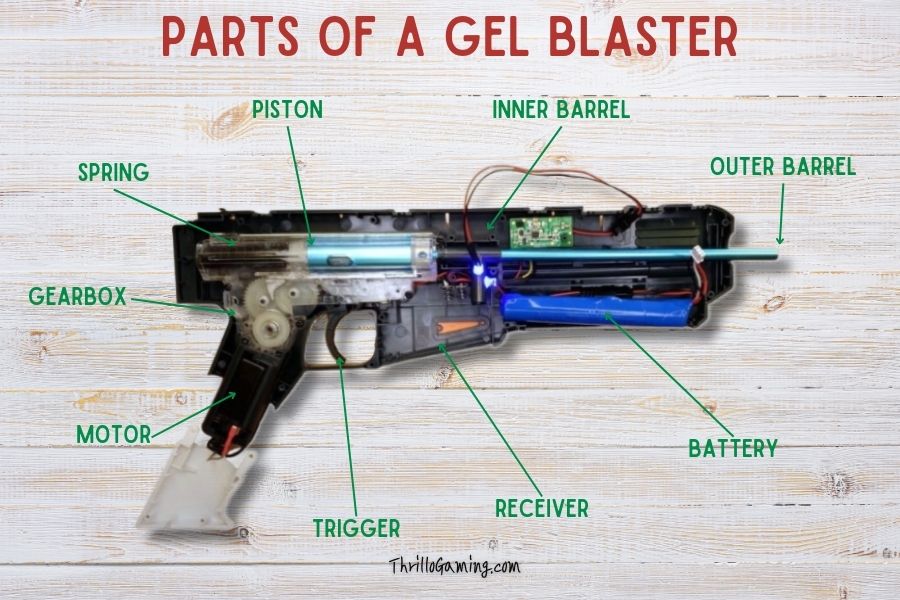As soon as I bought my first gel blaster gun, I was instantly intrigued by how these futuristic-looking toys managed to fire squishy, gel balls at such high speeds. I found myself spending countless hours taking them apart, tinkering with them, and modifying them to get a better understanding of how they work.
But my curiosity didn’t stop there. I wanted to know everything about these amazing toys – from the inner workings of their key components to the intricate details of each part’s function. And now, as an experienced gel blaster player and instructor, I have a wealth of knowledge about these exciting toys and their mechanics.
In this blog post, I’ll break down the key components of a gel ball blaster, explain how the firing mechanism works, and discuss the factors that can affect its performance. By the end of this post, you’ll have a clear understanding of how does a gel blaster work, so that you can use it properly. So, let’s dive in and explore!

Different Parts Of A Gel Blaster And Their Functions
To understand the working mechanism of a gel blaster, it’s crucial to know the different parts of the gun and their individual functions. Here are the key components:
- Receiver: This is the body of the gel blaster, which houses most of the internal components. It’s made of either metal or high-quality plastic and is the foundation on which the rest of the parts are mounted.
- Motor: The motor is what powers the firing mechanism of the gel blaster. It’s typically an electric motor that’s powered by a battery, and it rotates the gears inside the gearbox. Orbeez guns also have a similar motor inside the receiver.
- Battery: The battery inside a gel blaster gun provides power to the motor. It’s typically a 7.4V rechargeable lithium-ion battery that’s stored in a battery compartment in the stock of the gel blaster.
- Piston: It is responsible for compressing the air that fires the gel ball out of the barrel. The piston is usually made of plastic or metal and requires lubrication to function properly inside the splat gun.
- Spring: The spring is what provides the force to compress the piston and fire the gel ball. There are different strengths of springs that you can use to increase or decrease the velocity of the gel ball.
- Gearbox: This component is responsible for transferring power from the motor to the piston, which in turn compresses air to fire the gel balls. It’s a complex system of gears and springs that requires careful tuning and maintenance.
- Nozzle: This part of the gel blaster that directs the flow of air from the piston to the gel ball. It’s usually comprises of plastic or metal and requires careful alignment for optimal performance.
- Barrel: The barrel is where the gel ball travels before it’s fired out of the gel blaster. The length and diameter of the barrel can affect the accuracy and velocity of the gel ball.
- Inner Barrel: The gel ball travels through this part of the barrel before being fired. It’s usually made of metal and can be upgraded to improve accuracy of your gel blaster.
- Outer Barrel: It is the part of the barrel that is visible on the outside of the gel ball blaster. The outer barrel is usually built with metal or high-quality plastic and can be upgraded for aesthetics.
- Hop up: This is a small part located near the end of the barrel that puts spin on the gel ball on firing. This spin initiated by a hop up helps to stabilize the ball’s trajectory and increase accuracy.
- Magazine/ Hopper: The magazine is where the gel balls are stored before they’re fired. It’s typically consists of plastic and has a spring-loaded mechanism that feeds the balls into the firing chamber. Most Orbeez guns and splatter ball guns feature bottom-loading magazines, which serve the same function as top-loading hoppers on most gel blasters: feeding gel balls into the inner barrel.
- Trigger: It activates the motor to power the firing mechanism and typically located on the grip of the gel blaster. I can switch on and off the trigger with a flick of the finger.
- Mode Changer Switch: Many gel blasters come with multiple firing modes- Full Auto, Semi Auto and Manual. Such guns typically have a switch nearby the trigger to change to suitable mode according to the user’s requirements.
- Safety Switch: As the name suggests, this switch stops accidental firing, or else it could harm the eye or ear in a massive way. Some gel guns have magazine safety switches too.

The Working Mechanism Of Gel Blasters
A gel blaster works by using a motor to compress air and fire gel balls with precision and accuracy. When you pull the trigger, it activates the motor, which rotates the gears inside the gearbox. The gears transfer power from the motor to the piston, triggered by a spring.
The compressed air then forces the piston back, pulling back the spring. When you release the trigger, the spring pushes the piston forward, compressing the air in the cylinder. This compressed air then forces the gel ball out of the inner barrel and into the hop-up. The gel ball then exits the outer barrel, flying towards the target.
The magazine is used to load and hold the gel balls, and the battery powers the motor that drives the firing mechanism. The hop-up, inner and outer barrel, and gearbox are all designed to work together to produce an accurate and powerful shot.
Overall, the working mechanism of a gel blaster gun is based on the principles of compressed air, precision engineering, and the manipulation of small, squishy gel balls. Understanding how these different parts work together can help you use your gel blaster for maximum performance.
If you are interested, check out this video guide from Tactical Edge Hobbies on how a gel blaster works-
Factors That Affect The Performance Of A Gel Blaster
- Gel Ball Quality: The quality of the gel balls you use can greatly affect the performance of your blaster. Higher quality gel balls will be more consistent in size and will absorb water better, resulting in more consistent performance.
- Hop-up: The hop-up can be adjusted to increase or decrease the amount of backspin on the gel ball. Adjusting the hop-up can greatly affect the range and accuracy of your shots.
- Gearbox Components: Modifying and upgrading gearbox components such as the piston, cylinder, and gears can greatly improve the performance of your blaster gun. Upgraded components can increase the power and speed of your shots, resulting in a more competitive edge.
- Battery Life: The battery you use to power your gel blaster’s motor will affect its overall performance. A low-quality battery may not provide enough power to drive the motor properly, resulting in reduced firing speed and accuracy.
- Temperature And Humidity: The temperature and humidity can affect how gel balls expand and fire, which can impact performance. Hot and humid conditions can cause gel balls to expand too much and break, while cold and dry conditions can cause them to shrink and not fire properly.
So, we see that functionality and mechanism are not rocket science! If you know the gel blaster’s function, mechanism, or operation process, it helps you solve minor glitches, and you can take all precautions while cleaning and maintenance.
The operation of a gel blaster is similar to that of a splatter ball gun or Orbeez gun. By taking the time to understand how these toys work, you can enjoy a smooth and consistent shooting experience every time.
Also Read:

